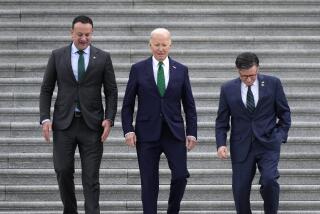Money Supply Surges $3.7 Billion
- Share via
NEW YORK — The nation’s basic money supply shot up $3.7 billion in early September, bringing its explosive rise to $21.6 billion over the past eight weeks, according to a Federal Reserve Board report Thursday.
The latest increase pushed M1, the money supply measure that represents cash readily available for spending, further above the upper limits of growth targets set by the Fed in its attempt to encourage non-inflationary economic growth.
But analysts said that, until there were clear signs of a sustained pickup in the economy, it was unlikely that the Fed would change policy and push interest rates higher to rein in the runaway money supply growth.
“For now, it’s steady as she goes,” David Jones, an economist at the New York government securities firm Aubrey G. Lanston & Co., said of Fed policy.
The Fed said M1 rose to a seasonally adjusted $613.4 billion in the week ended Sept. 9 from $609.7 billion in the previous week. M1 includes cash in circulation, deposits in checking accounts and non-bank travelers checks.
For the latest 13 weeks, M1 averaged $600.1 billion, a 15.1% seasonally adjusted annual rate of gain from the previous 13 weeks.
The Fed has said it would like to see M1 grow between 3% and 8% from the second quarter of this year through the fourth quarter.
Although M1 continued to exceed Fed targets, the latest figures had little impact on financial markets, where interest rates were little changed after the report was released at 4:30 p.m. EDT.
“The market has come to believe that the Fed is looking beyond M1 to GNP,” said Harold Nathan, an economist at Wells Fargo Bank in San Francisco.
Today, the government is scheduled to release its first estimate of growth of the gross national product for the July-September quarter.
Nathan said growth above an annual rate of 3.5% would be viewed in financial markets as a signal of rising interest rates. Growth in the first six months of the year was a listless 1.1%.
Nathan said that, even if the economy showed new sparks of life, the Fed would want more evidence on a sustained rapid expansion before shifting to a more restrictive policy.
Kathleen Cooper, an economist at Security Pacific National Bank, said, “The Fed is ignoring money until it is sure the economy is growing substantially.”
In other reports:
- The Federal Reserve Bank of New York reported that commercial and industrial loans at major New York City banks fell $423 million in the week ended Sept. 11, compared to a gain of $985 million a week earlier. It said commercial paper--or short-term corporate IOUs--outstanding nationwide fell $622 million in the week ended Sept. 11 after rising $2.324 billion in the previous week.
- The Fed said bank borrowings from the Federal Reserve System averaged $421 million in the week ended Wednesday, down from $422 million in the previous week. Borrowings averaged $723 million in the two-week period ended Sept. 11, up from $478 million in the previous two weeks.
More to Read
Inside the business of entertainment
The Wide Shot brings you news, analysis and insights on everything from streaming wars to production — and what it all means for the future.
You may occasionally receive promotional content from the Los Angeles Times.










